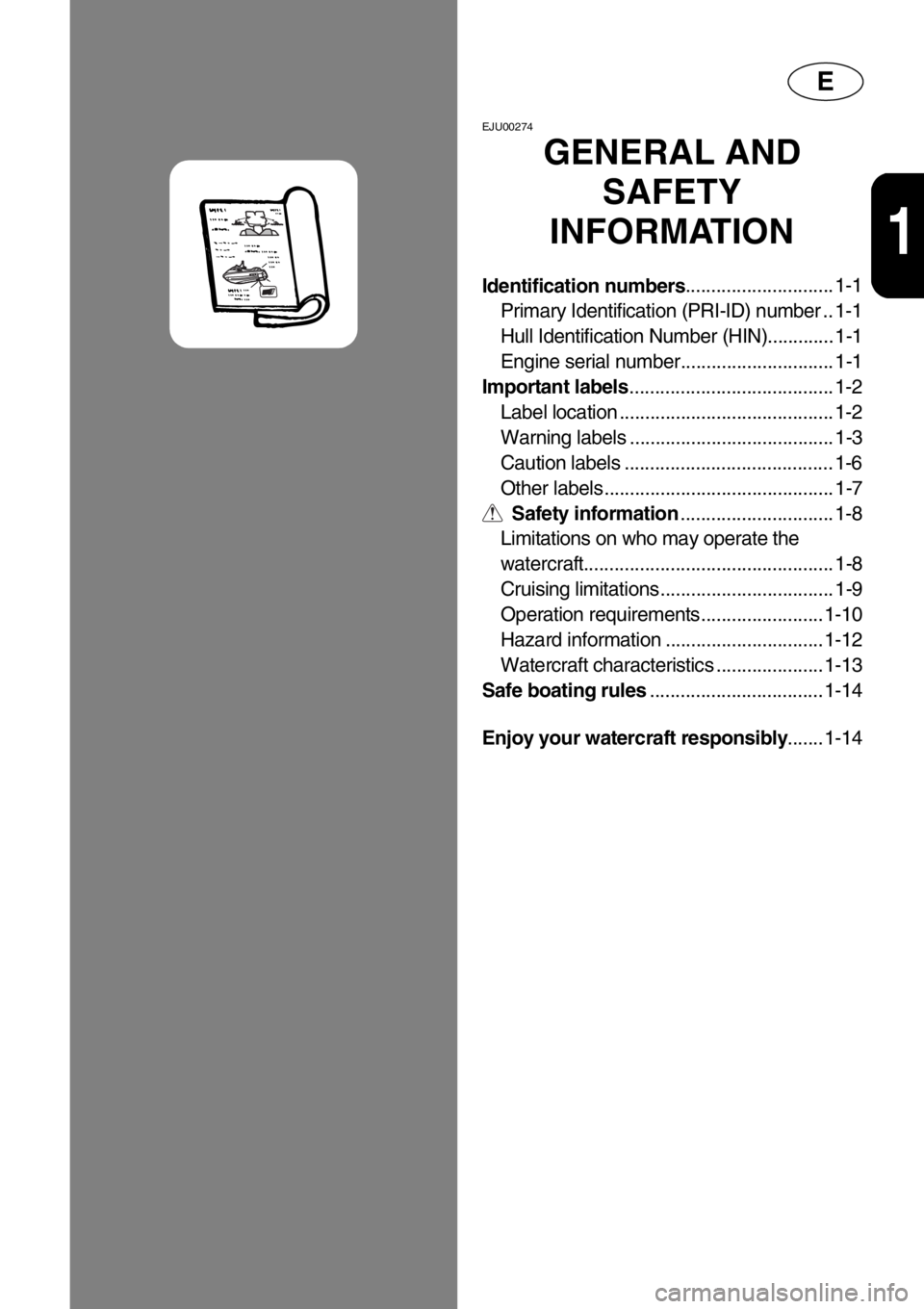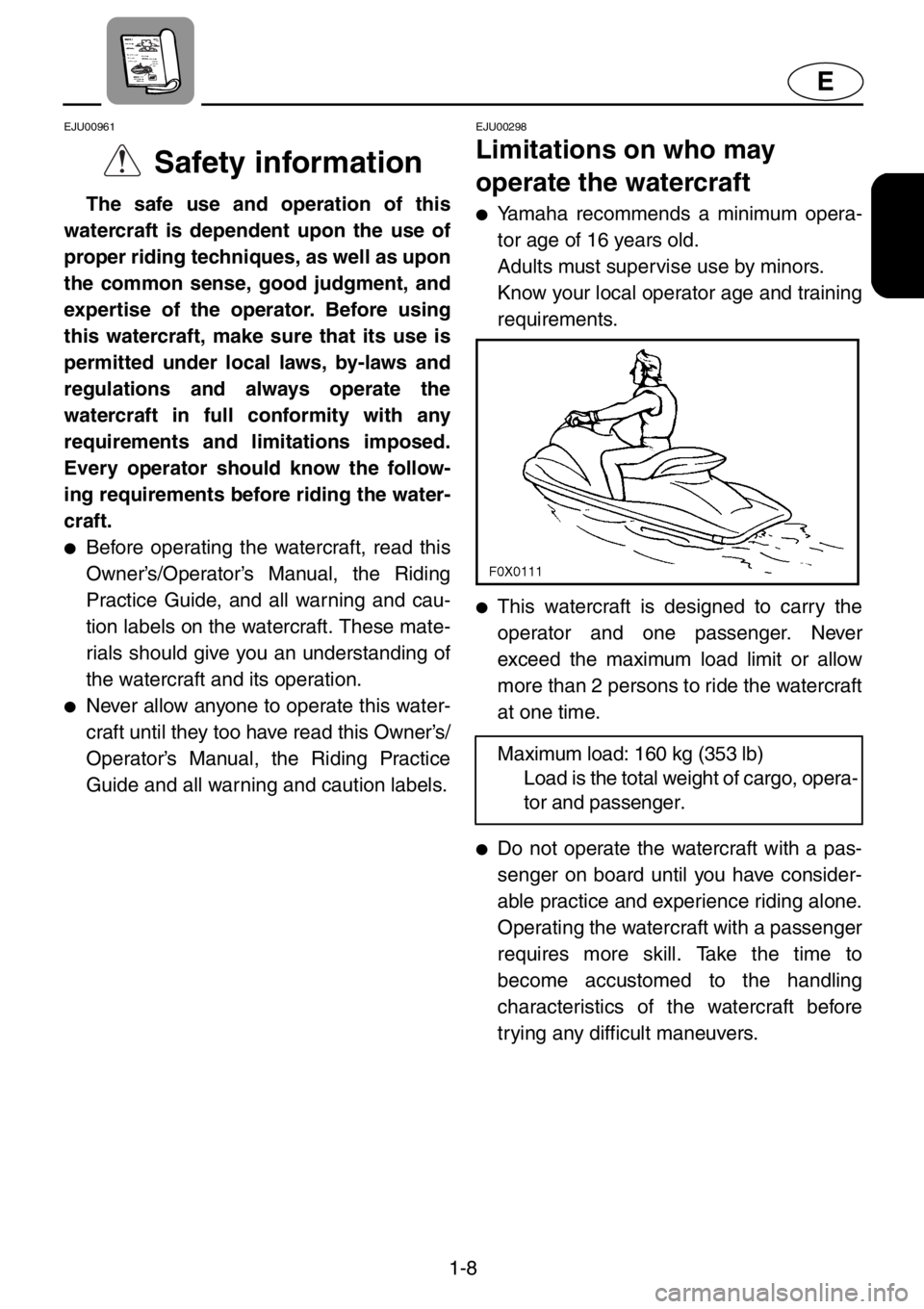Page 3 of 119

E
EJU00270
To the owner/operator
Thank you for choosing a Yamaha water-
craft.
This Owner’s/Operator’s Manual contains
information you will need for proper opera-
tion, maintenance, and care. A thorough
understanding of these simple instructions
will help you to obtain maximum enjoyment
from your new Yamaha. If you have any
questions about the operation or mainte-
nance of your watercraft, please consult a
Yamaha dealer.
Because Yamaha has a policy of continu-
ing product improvement, this product may
not be exactly as described in this Owner’s/
Operator’s Manual. Specifications are sub-
ject to change without notice.
This manual should be considered a per-
manent part of this watercraft and should
remain with it even if the watercraft is subse-
quently sold.Important manual information:
In this manual, information of particular
importance is distinguished in the following
ways:
The Safety Alert Symbol means
ATTENTION! BECOME ALERT!
YOUR SAFETY IS INVOLVED!
WARNING
Failure to follow WARNING instructions
could result in severe injury or death to
the machine operator, passenger(s), a
bystander, or a person inspecting or
repairing the watercraft.
CAUTION:
A CAUTION indicates special precau-
tions that must be taken to avoid damage
to the watercraft.
NOTE:
A NOTE provides key information to make
procedures easier or clearer.
EJU00272
WaveRunner GP1200R
OWNER’S/OPERATOR’S MANUAL
©2000 by Yamaha Motor Co., Ltd.
1st Edition, November 2000
All rights reserved.
Any reprinting or unauthorized use
without the written permission of
Yamaha Motor Co., Ltd.
is expressly prohibited.
Printed in USA
Page 7 of 119

E
1
EJU00274
GENERAL AND
SAFETY
INFORMATION
Identification numbers............................. 1-1
Primary Identification (PRI-ID) number .. 1-1
Hull Identification Number (HIN)............. 1-1
Engine serial number.............................. 1-1
Important labels........................................ 1-2
Label location .......................................... 1-2
Warning labels ........................................ 1-3
Caution labels ......................................... 1-6
Other labels ............................................. 1-7
Safety information.............................. 1-8
Limitations on who may operate the
watercraft................................................. 1-8
Cruising limitations .................................. 1-9
Operation requirements........................ 1-10
Hazard information ............................... 1-12
Watercraft characteristics ..................... 1-13
Safe boating rules.................................. 1-14
Enjoy your watercraft responsibly....... 1-14
Page 10 of 119
Page 15 of 119

1-8
E
EJU00961
Safety information
The safe use and operation of this
watercraft is dependent upon the use of
proper riding techniques, as well as upon
the common sense, good judgment, and
expertise of the operator. Before using
this watercraft, make sure that its use is
permitted under local laws, by-laws and
regulations and always operate the
watercraft in full conformity with any
requirements and limitations imposed.
Every operator should know the follow-
ing requirements before riding the water-
craft.
●Before operating the watercraft, read this
Owner’s/Operator’s Manual, the Riding
Practice Guide, and all warning and cau-
tion labels on the watercraft. These mate-
rials should give you an understanding of
the watercraft and its operation.
●Never allow anyone to operate this water-
craft until they too have read this Owner’s/
Operator’s Manual, the Riding Practice
Guide and all warning and caution labels.
EJU00298
Limitations on who may
operate the watercraft
●Yamaha recommends a minimum opera-
tor age of 16 years old.
Adults must supervise use by minors.
Know your local operator age and training
requirements.
●This watercraft is designed to carry the
operator and one passenger. Never
exceed the maximum load limit or allow
more than 2 persons to ride the watercraft
at one time.
●Do not operate the watercraft with a pas-
senger on board until you have consider-
able practice and experience riding alone.
Operating the watercraft with a passenger
requires more skill. Take the time to
become accustomed to the handling
characteristics of the watercraft before
trying any difficult maneuvers.
Maximum load: 160 kg (353 lb)
Load is the total weight of cargo, opera-
tor and passenger.
Page 23 of 119

E
2
EJU00326
FEATURES AND
FUNCTIONS
Location of main components............... 2-1
Operation of controls and other
functions.................................................... 2-5
Seat ......................................................... 2-5
Hood ........................................................ 2-6
Fuel tank filler cap ................................... 2-6
Oil tank filler cap...................................... 2-6
Fuel cock knob........................................ 2-7
Engine stop switch .................................. 2-8
Engine shut-off switch............................. 2-8
Choke lever ............................................. 2-8
Throttle lever ........................................... 2-9
Start switch.............................................. 2-9
Cooling water pilot outlet ...................... 2-10
Steering system .................................... 2-10
Quick Shift Trim System (QSTS)
selector .................................................. 2-11
Engine overheat warning system ......... 2-13
Handgrip................................................ 2-14
Multifunction information center........... 2-15
Tachometer ........................................... 2-16
Speedometer ........................................ 2-16
Reset button.......................................... 2-16
Fuel meter ............................................. 2-17
Hour meter ............................................ 2-17
Fuel warning indicator........................... 2-18
Oil warning indicator ............................. 2-18
Engine overheat warning indicator....... 2-19
Storage compartments ......................... 2-20
Yamaha Adjustable Sponson
(Y.A.S.) .................................................. 2-21
Page 31 of 119
2-8
E
EJU00705
Engine stop switch
Push this switch 1 (red button) to stop
the engine normally.
EJU00706
Engine shut-off switch
Insert the clip 1, on the end of the engine
shut-off cord 2, under the engine shut-off
switch 3 (black button). The engine will stop
automatically when the clip is removed from
the switch, such as if the operator falls off
the watercraft.
WARNING
●Always attach the engine shut-off cord
to your wrist and the clip to the engine
shut-off switch BEFORE starting the
engine.
●To prevent accidental starting of the
engine or unauthorized use by chil-
dren or others, always remove the clip
from the shut-off switch when the
engine is not running.
EJU00350
Choke lever
Starting a cold engine requires a richer
air-fuel mixture, which is supplied by the
choke.
Move the lever 1 in direction a to turn
the choke on.
Move the lever in direction b to turn the
choke off.
Page 36 of 119

2-13
E
EJU00366
Engine overheat warning
system
This model is equipped with an engine
overheat warning system.
If the engine starts to overheat, the warn-
ing light and the engine overheat warning
indicator begin to blink, and the buzzer
sounds intermittently.
When this occurs, check for water dis-
charge at the cooling water pilot outlet. If
there is no discharge of water, reduce
engine speed and beach the watercraft, and
then check the intake grate and impeller for
clogging.
WARNING
Before attempting to remove weeds or
debris from the intake grate or impeller,
shut the engine off and remove the clip
from the engine shut-off switch. Severe
injury or death could result from coming
in contact with the rotating parts of the
jet pump.
CAUTION:
●When the warning system is activated,
reduce engine speed and beach the
watercraft. If these signals are ignored,
the engine will shut off and it cannot
be started until the engine cools.
●If you cannot locate and correct the
cause of the overheating, consult a
Yamaha dealer. Continuing to operate
at higher speeds could result in severe
engine damage.
NOTE:
Press the reset button on the multifunction
information center to stop the buzzer.
Page 37 of 119

2-14
E
If the overheat warning is ignored, engine
heat may increase, particularly if the water-
craft is operated at higher speeds. When
this occurs, the warning light and engine
overheat warning indicator begin to blink
rapidly, the buzzer sounds continuously, and
the overheat system will stop ignition to the
engine to reduce the risk of severe over-
heating. The engine cannot be started until
it cools down, so it may be necessary to
have the watercraft towed back to the
beach. (See “Towing the watercraft” on page
5-7 for towing procedures.)
CAUTION:
If you cannot locate and correct the cause of
the overheating, consult a Yamaha dealer.
Continuing to operate at higher speeds
could result in severe engine damage.
NOTE:
Press the reset button on the multifunction
information center to stop the buzzer.
EJU00367a
Handgrip
The handgrip 1 provides a handhold for
boarding the watercraft.
CAUTION:
Do not use to tow objects, lift watercraft,
or attach tie downs, otherwise damage
could occur.